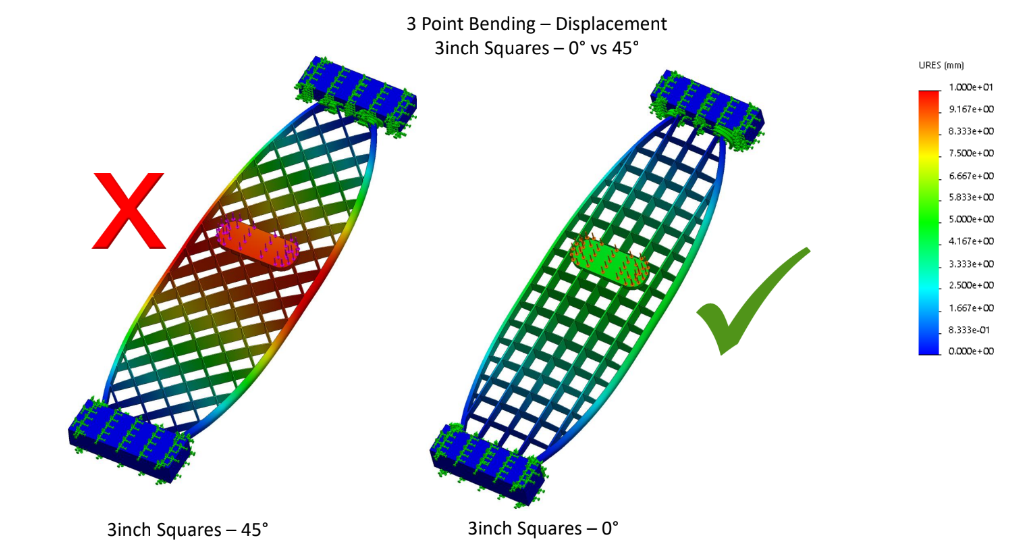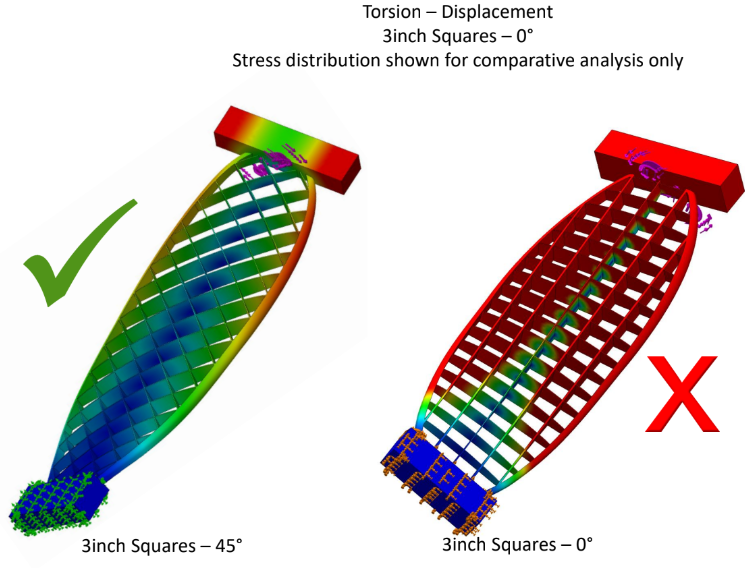Board Flex and Feel
One of the things we can do with 3D-printing is control the way our board flexes and rebounds under the surfer’s feet. Like the spring and damper on a car or mountain bike suspension, our boards really have two separate parts: the 3D-printed plastic frame, and the composite (fiberglass, secret layer(s), bio-epoxy) skin. Each part has its own unique way of flexing, storing energy like a spring, and then popping back to its original position. The composite skin, for example, responds in a pretty linear way: the more you flex it, the more it wants to pop back into place. It probably dissipates a consistent percentage of energy each time. For comparison, carbon fiber dissipates almost no energy when it flexes and rebounds, which is why carbon stringers make boards more lively and responsive. Carbon is also much stiffer than fiberglass, which is why it takes some real talent on the part of the surfer and the designer to get the most out of a carbon layup.
Our plastic core, however, is a whole different animal. Because we are 3D-printing an open structure, we can customize the way our core responds in different directions and different scenarios. Overall, the plastic wants to rebound more slowly than the composite skin, and adds a damping effect to vibrations throughout the board. For the surfer, that translates into a smooth, silky feeling that can even soak up texture on the face of the wave. To make sure our boards don’t feel dead and boring, though, we put a lot of work into discovering how different parts of our structure affect the way the board feels. Damping vibration is good, but damping responsiveness usually isn’t.
Based on our FEA modeling and the boards we’ve made so far, here’s what we learned:
Stringers in the frame make the board stiffer, and harder to flex.
A stringer under the surfer’s feet translates input from the surfer into the frame, making it feel more responsive.
Stringers near the rails dramatically increase torsional stiffness, which should help the surfer generate speed more efficiently.
Diagonals running across the board support the weight of the surfer, and the more they run along the board (instead of across the board) the more they increase stiffness in bending and decrease stiffness in torsion. If they run across the board at a 45 degree angle or more, they make for a very bendy board.
In a board with lots of diagonals and no stringers, the flex and feel of the board can be determined more by the composite skin. The more stringers a board has, the more the plastic frame controls flex and feel.
What does this all mean for our boards? Well, for example, a fast and smooth shape like our SeaMink might get stringers near the rails to boost speed, but no stringers underfoot so it has a silky smooth ride. A more responsive shape like a fish might get stringers along the rails and down the centerline, so that it can respond quickly to more aggressive inputs from the surfer. If we wanted to produce a performance shortboard, we might use no stringers and make the feel of the plastic core structure imperceptible, but add some carbon to the skin layup. A custom board for a heavier surfer might get 4 stringers, while 2 stringers might work better for a light surfer.
We’re still testing a bunch of new ideas, but this is one that we’re pretty stoked on. We think it can really make a difference, even for intermediate surfers who are still learning to generate speed and lean into their rails.



